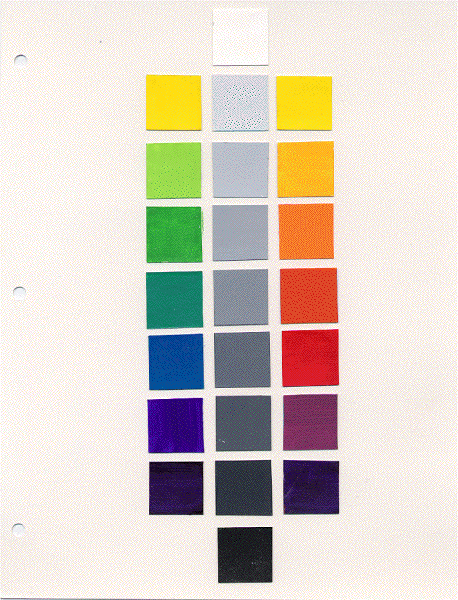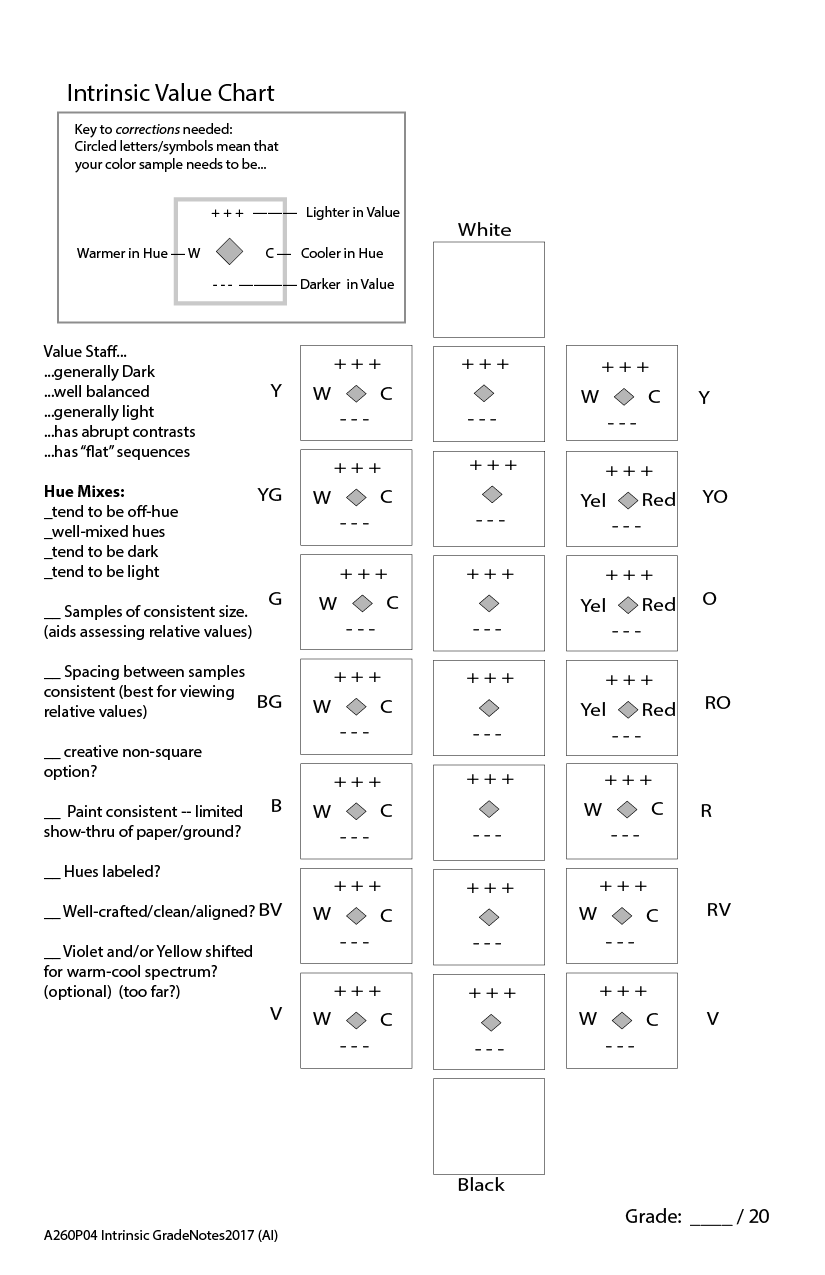Intrinsic Value Plate
Art 260 / Greg Clayton
Study of Intrinsic Values of Major Hues
Create a set of color samples representing each of the major hues at their ideal intrinsic value.
Intrinsic value relates to the inherent potential and limitation present in each hue. That is, each hue has its own possibilities of chroma and value, and thus of color. The designer needs to be able to think in terms of what a color is visually capable of in order to design harmonies that are possible as well as effective.
This plate is primarily a color mixing and visual discrimination exercise.One key mixing challenge involves controlling both hue and value.
A key color-discernment challenge is creating even steps, or changes, between hues.
Goals
- Become visually familiar with the intrinsic value of each hue.
- Refine your ability to control color mixes.
- Refine your ability to distinguish hue traits — especially hue contrast.
- Refine your ability to distinguish value.
- One key mixing challenge involves controlling both hue and value at the same time.
- A key color-discernment challenge involves creating even steps, or changes, between hues.
Methods
Requirements:
- Mix a fresh value staff with 9 evenly distributed samples.
- Each hue should be at its ideal "Munsell 5 position" — with the addition of YO and RO (the two hues present in a 12-hue wheel, but not in a Munsell 10-hue wheel). Thus, you will need to discriminate hues accurately as well as "hue contrast" — the difference between hues.
- Each hue should be mixed to its theoretical intrinsic value. The value of each chromatic sample should match the value next to it.
Getting Started:
- Get one of the large ~8.5"x11" plates.
- Get (at least) 23 of the small 1" squares.
Suggested Working Method:
Create a reliable value staff first. (this is in addition to your earlier value-staff-only plate)
All of your subsequent color mixes will be based on comparisons to this value staff. If your values are too dark or too light, your chromatic mixes will be off.Create the cool side color swatches.
Create the warm side color swatches.
Label each hue with its one- or two-letter abbreviation (i.e. R, RO, O, YO....)
The Concept
 |
As illustrated to the left, Intrinsic Value has to do with the natural or "native" value of each hue. Every hue has a value at which it offers the greatest range of Chroma. |
|
Samples
 |
Your challenge is to create your second value staff, and then mix hues that match those values. All colors on the same row should match in value. Hues should "step" evenly, from one hue to another. (Yellow is repeated twice. Here you might offer a cool yellow and a warm yellow) (Violet is also repeated twice — on both left and right of the value staff.) You may use the pre-cut 1" squares...or be more creative! |
|
Alternatives and Suggestions
Transitional Hues:
Yellow(s):
Recall that yellow samples repeat on both warm side and cool side.
You may create a slightly cool yellow (YYG) on one side, and a slightly warm yellow on the other (YYO, such as Cadmium Yellow), but these two colors should be very close — just barely splitting the primary.
Violet(s):
Note that violet samples also repeat at the bottom of both warm and cool sides.
You might create a violet that is very slightly warm (RV) and a violet that is very slightly cool (BV). However, the very low intrinsic value of violet will make this difficult to see, and thus difficult to control.Dioxazine Purple:
This hue is usually too dark for even a value 2. Expect to add a bit of white in order to match its ideal intrinsic value.Blue-Green:
Expect to fine-tune the hue (see note on Tertiary Colors, below). Also expect that the Pthalo pigments are both very powerful (a lot of tinting strength) and very dark. You'll usually need to lighten them to hit the BG intrinsic value.Blue:
Most out-of-the-tube blue paints are rather blue-violet. (Brilliant Blue is an exception — it is close ideal blue, even a bit BG) In order to get an ideal "Munsell 5" blue, expect to mix a greener blue (Thalo Blue) or even a bit of Blue-Green to correct that hue bias.
Note also that, like Dioxazine Purple, most blue pigments are darker than blue's intrinsic value.Tertiary Colors:
(YG, YO, RO, RV, BV, BG) These tend to be tricky hues to "hit". You'll have to look hard at the "hue contrast" between neighboring colors. That is, when you mix YO, you should already have your Yellow sample and your Orange sample. Mix your YO color until it is as far from Yellow as it is from Orange (or, if you like, as close to Orange as it is to Yellow. In any case, the contrast should be the same.) That's the tough hue-discrimination problem. Patiently look at these fine differences until your eye gradually trains itself to see more than it is accustomed to seeing. Its a bit like exercising your muscles to do more tomorrow than they can do today.
Crit Sheet
Most crit issues involved in grading this exercise are noted on the crit sheet below:
